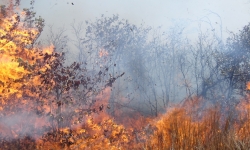CSIR develops practical approaches to reducing fire risks in the wildland-urban interface
The CSIR has developed a 10-step process to assess and reduce the risks of wildland fires and map the likelihood of fire. The 10 steps entail the delineation of the wildlife-urban interface, where a 100 m buffer is created on either side to allow for the characterisation of assets and fuel types. Thereafter, zones are created that cluster similar types of hazards such as buildings and wildland fuels. This allows for assessments to be made with regards to the likelihood of a wildfire occurring and the resultant consequences for the assets in each zone. The degree of risks is then mapped using risk classes, which are revised prior to each fire season.
This approach enables fire managers to gain a better understanding of the location of high fire risks under current fire regimes and direct their investments accordingly. CSIR fire specialists recommend that buffer zones, or firebelts, be appropriately designed and maintained to effectively protect assets, and that fuels need to be managed to reduce the vulnerability of assets to wildfires.
This approach can be used to assess and analyse wildfire risks and apply practical wildfire management measures which respond to local ecological, social and institutional settings, thereby protecting livelihoods, property and biodiversity.




